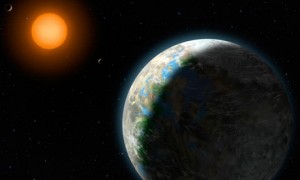 For the first time, astronomers have detected a rocky planet in another solar system that has the most basic and essential conditions needed to support extraterrestrial life.
For the first time, astronomers have detected a rocky planet in another solar system that has the most basic and essential conditions needed to support extraterrestrial life.
The presence of Earth-like exoplanets in what is called the “habitable zone” has been predicted for some time, but actually identifying and measuring one was referred to Wednesday as the beginning of a new era in the search for life beyond Earth.
“This is our first Goldilocks planet – just the right size and the right distance from its sun,” said astronomer and “planet-hunter” Paul Butler with the Carnegie Institution of Washington. “A threshold has been crossed.”
The planet, called Gliese 581G, is quite close at 20 light years from Earth’s solar system. It is considered to be in the habitable zone because of its distance from its sun and its size.
Together, those two measurements tell scientists that any water on the planet will be in liquid form, and that the planet is large enough to have the gravitational pull to hold an atmosphere around it.
Butler and colleague Steven Vogt of the University of California at Santa Cruz said their discovery, which was published in the Astrophysical Journal, was pieced together by collecting data over 11 years, does not mean that life necessarily exists on the planet. Rather, they said, the basic conditions are present to allow it to begin and keep it going. And from their research, they strongly believe similar conditions are present in many other solar systems.
“This is clearly one of the most exciting areas of science these days,” said Edward Seidel of the National Science Foundation, which has helped support Butler’s work for almost 25 years. “If we do discover life outside our planet, it would perhaps be the most significant discovery of all time.”
Adding to the significance of the discovery, the star Gliese 581 is now known to have six and perhaps seven planets orbiting it. And unlike most distant solar systems detected so far, the planets all orbit in a circular path and are lined up by type in a way similar to our solar system.
“As we collect more data, we can see the system looks like our own – with an inner clutch of rocky, terrestrial planets and then a big loner like Jupiter further out,” Vogt said.
It is significantly different, however, because the central sun is an M dwarf, a star with only 1 percent of the power that comes off Earth’s sun. All the planets in the system are closer to their sun than the Earth is to its sun.
Butler and Vogt said the likelihood of finding many more planets in habitable zones has greatly increased because of where this first one was found and how long it took to find it. Gliese 581 is one of the stars closest to Earth (86th in distance from our solar system), and so is one of the easiest to study for exoplanets. In addition, it took 11 years of observing to tease out the presence of the habitable zone planet, a short time in astronomical terms.
“The logic now says there are lots of planets like this out there,” Vogt said.
The research was funded by the National Science Foundation, NASA and some private sources.
The first exoplanet was detected in 1995 by a Swiss team and then quickly confirmed by Butler and his then-colleague Geoffrey Marcy. Since then, almost 500 exoplanets have been found, but many have been large gas giants like uninhabitable Jupiter.
But as techniques for finding exoplanets have become more precise, the ability of astronomers to find smaller ones has improved.
The scientific excitement about exoplanets was reflected in August, when the National Academy of Sciences’ 10-year survey of astronomy placed exoplanet study near the top of the field’s priorities.
In addition to discovering more and hopefully smaller planets, the study said, astronomers should be thinking about ways to learn about the chemical makeup of distant planets and their atmospheres. In particular, they should look for oxygen, ozone, methane and other “biosignatures” that suggest the presence of some form of biology.
The work by Butler and Vogt was mostly done at the W.M. Keck Observatory on the dormant Mauna Kea volcano in Hawaii and involves indirect measurements of the “wobble” of a target star that is created by the gravitational pull of an orbiting planet. It took 240 lengthy observations of Gliese 581 by the Americans and a Swiss team before Butler and Vogt were able to tease out the measurements of a habitable zone planet.
The newly discovered planet is locked in relation to its sun the way the moon is locked in relation to Earth – with only one side bathed in sunlight. But the researchers said the extremes of dark cold and bright heat are reduced along a band that circles the planet where the dark and light meet, creating a wide range of promising environmental niches.
Those areas are large enough, Butler said, for heat-loving creatures to live on the sun-facing region of the band and polar bears on the cold-facing side. He also said that because the planet does not rotate on an axis, the view from these areas would be of perpetual sunrise or sunset.
Red dwarf stars like Gliese 581 are considered among the longest living in the universe, so they can potentially provide a stable stellar environment for eons – an important factor in setting the conditions for life. The Earth’s sun is also relatively long-lived but will cool to the point that Earthly life is impossible long before Gliese 581 loses its force.
Leave a Reply
You must be logged in to post a comment.